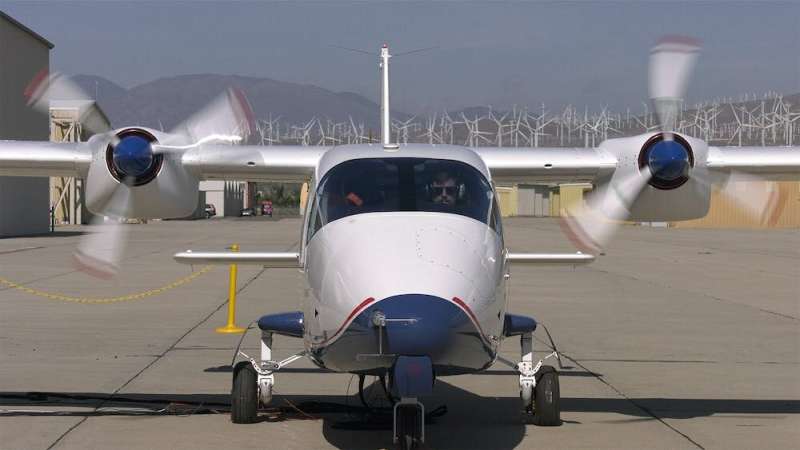X-57: NASA’s electric plane is preparing to fly—here’s how it advances emissions-free aviation
The experimental airplane X-57, developed by NASA, is due to fly for the first time this year. It has an impressive 14 propellers along its wings and is powered entirely by electricity. This sounds great considering we have to get off fossil fuels yet our demand for aviation is growing. But how much closer will NASA’s plane bring us to this goal?
Finding an alternative to aviation fuels such as kerosene will be key if we want to continue flying. The X-57 uses lithium batteries to run electric motors for its propellers. But the energy you get from batteries, relative to their weight, is 50 times less than you can get from aviation fuel.
The X-57 is a modified, four-seater, Italian-built Tecnam P2006T aircraft. It relies on a combination of lots of propellers, small motors and many batteries spread out across an aircraft, known as “distributed propulsion”. This approach represents an exciting area of research and development that can be found in many experimental electric aircraft designs.
What’s different about the X-57 is that the wings are completely redesigned with propellers positioned to optimize air flow around them. When a propeller is not needed, its blades can be folded back to reduce drag.
Propeller technology generally is having a rebirth. Designs are becoming not just more efficient, but also less noisy and more affordable. The speed and pitch angle of propellers can even be changed during flight to adapt to the different aircraft speeds required for takeoff, landing and cruising.
Air density changes with altitude and affects the thrust you get from a propeller. Now that we can make propellers that work effectively at all altitudes and speeds, we can really get the most out of the energy stored in the batteries. New designs, such as the first ever 11-bladed propeller (on the Piper Cheyenne plane), can achieve very high thrust even at high air density.
Some aircraft even use “vectored thrust” by allowing the motors and propellers to rotate, which gives the option of vertical takeoff and landing. These aircraft might more resemble helicopters than planes, and might mean conventional airports with long runways and large terminals will be a thing of the past.
Battery technology
The X-57 uses off-the-shelf lithium-ion batteries. This is because the project is primarily addressing the potential for new propeller and wing configurations rather than developing the perfect battery.

But that will be an important challenge for electric aircraft developers to overcome. Lithium batteries are pretty much the best we’ve got so far, but they are still heavy. Lithium metal is also hazardous as it catches fire easily.
There are advantages with using batteries. Their weight stays constant throughout the flight, meaning they don’t need to be stored in the wings as aviation fuel traditionally has been. With liquid fuel, the weight of the plane reduces significantly as fuel is consumed and keeping the fuel in the wings ensures that the balance of the aircraft isn’t changed.
However, it is really energy density—the amount of energy a battery contains compared to its weight or size—that matters. New advances are being made constantly, such as batteries created based on quantum technology. But while these charge faster than normal batteries they won’t replace lithium batteries and are unlikely to transform the prospects for electrically powered flight.
What we’re really waiting for is a revolution in battery technology, one that gives an energy density comparable to aviation fuel.
Is X-57 the future?
With a range of about 160km and a flight time of about one hour, the X-57 is not expected to lead to a replacement technology for long-haul flying. At least not straight away. Instead, short-hop flights with ten or so passengers are a good and potentially possible target for early, battery-powered flights.
Hydrogen-powered planes are also of great interest because the energy density of hydrogen is nearly three times greater that that of conventional aviation fuel. But hydrogen is a gas and it needs to be stored in pressurized fuel tanks to reduce its volume.
This would require a complete rethink of aircraft design. Some work has been done with hydrogen stored as a liquid at -253°C. Hydrogen for aviation is therefore exciting, but probably impractical.
Synthetic fuels are ready to go as a substitute for aviation fuels—at a price. Perhaps as technologies develop, they’ll become cheaper, but it’s still likely that the cost of flying will increase as we move away from fossil fuels. Batteries will almost certainly be powering our short-haul flights in the near future and if there is a revolution in battery technology then the future of aviation will be completely changed.
Eventually, we will be faced with an ultimatum: either we figure out how to make planes that don’t need fossil fuels, or we stop flying.
This article is republished from The Conversation under a Creative Commons license. Read the original article.![]()
Citation:
X-57: NASA’s electric plane is preparing to fly—here’s how it advances emissions-free aviation (2023, January 31)
retrieved 31 January 2023
from https://techxplore.com/news/2023-01-x-nasa-electric-plane-flyhere.html
This document is subject to copyright. Apart from any fair dealing for the purpose of private study or research, no
part may be reproduced without the written permission. The content is provided for information purposes only.
For all the latest Technology News Click Here
For the latest news and updates, follow us on Google News.
